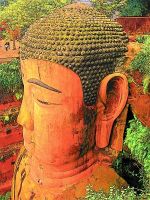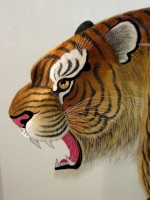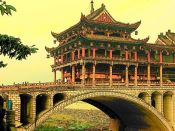A night at the opera might mean a variety of powerful and beautiful voices singing a ballad of some sort — or at the very least a phantom shows up.
Not so at the Sichuan Opera where a fire-breathing performer made for a dramatic backdrop to a quick-change artist, who managed to change mask and costume as fast as it took to swipe a huge fan in front of him.
It was incredible magic, really. How did he do that, anyway? You’ve got to check out the video for a taste.
There was some singing that I’m certain told a beautiful tale, and a man who balanced a bowl with a flame on his head as he crawled under benches in a comedy sketch that said the man was tired of doing what his wife said.
Funny, you couldn’t understand it totally, but you got the idea.
But without question, the highlight was an incredible hand-shadow artist who transformed his 10 digits into a flying bird that sat and pecked at his mouth, a running rabbit, a galloping horse — an incredible sight — and a coyote looking down on a rabbit and eating it. You actually saw the rabbit going down the coyote’s throat.
He also used his forearms and head to fashion an owl with eyes that moved back and forth.
The entire show was great theater and nothing you’d expect from your typical opera. And before the show, you can walk right into the dressing area and watch the performers put on their makeup.
If you have a free night in Chengdu, take in the opera. You won’t regret it.
FINAL NOTE:
Suǒyǒu zhèxiē zhōngshí xìntú “zhōng piàn sìchuān,” xièxiè dàjiā yì qǐ wèi qí. Wǒ xīwàng nǐ xǐhuan de màoxiǎn.
Zhè hěn yǒuqù chóngxīn shēnghuó wǒ qù chéngdū hé sìchuān, hé fēnxiǎng wǒ de shíkè.
Wǒ qiángliè jiànyì nǐ kǎolǜ dào zhōngguó lǚxíng. Yuē měi tiān 100 yuán, nǐ kěyǐ dédào yīgè sì xīng jí jiǔdiàn, jiāotōng, dǎoyóu hé ménpiào suǒyǒu jǐngdiǎn. Zhè shì zhídé de.
Zàijiàn le dàjiā!
TRANSLATION:
To all those faithful followers of “A Slice of Sichuan,” thanks for coming along for the ride. I hope you enjoyed the adventures.
It was fun re-living my trip to Chengdu and the Sichuan Province, and sharing my moments with you.
I highly recommend you consider a trip to China. For about $100 a day, you can get a four-star hotel, transportation, food, a guide and tickets to all the attractions. It’s well worth it.
Goodbye all!
Yours truly,
The SichuanChinaTraveler
aka David Strege




 Posted by David Strege
Posted by David Strege 







